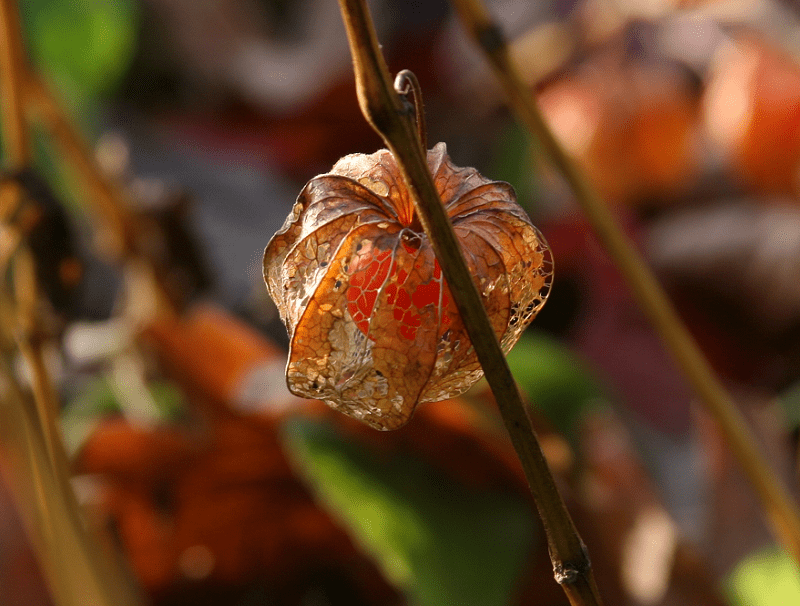
Chinese Lantern Facts
- First of all, the term Chinese Lantern serves as the common name for an incredibly beautiful variety of perennial plant. However, it also goes by the scientific name of the Physalis alkekengi. It holds a surprise for many people who admire its beauty, though. That’s because this species actually remains a relative of the deadly nightshade plant, named Atropa Belladonna.
- Furthermore, the surprising plant can also be easily recognized by the unique covering on its fruit. Perhaps even more uniquely, this actually varies in color. In an amazing natural coincidence, the wispy thin coverings over the fruit resemble popular lanterns in China. This, quite understandably, serves as the source of the distinctive common name for the remarkable plant.
- The Chinese Lantern has become a popular ornamental species, due to its bright colors and appearance. These easily set it apart from other species. Furthermore, various parts of the plant also contain chemicals used in medicines. Thankfully, for the moment its numbers appear to be stable. Therefore, the IUCN presently has no listing for it. Nonetheless, climate change could threaten it.
Related Articles
Chinese Lantern Physical Description
Firstly, the serenely gorgeous Chinese Lantern evolved as a visually remarkable variety of herbaceous perennial. In addition, the breathtaking marvel of Nature typically grows in an upright clump. Each plant attains an average measurement equaling roughly 24 in (61 cm) in both height and width.
Its foliage also merits appreciation. That’s due to the fact that the dark green leaves grow abundantly, and measure about 3 in (7.5 cm) in length. Further, the white flowers develop small and somewhat sparse in number. It’s perhaps best known for the lacy covering over the fruit. This serves as a protective layer.
But Nature did not stop at this point, with providing the amazing species with wonders. That holds true due to the fact that, while its fruit remains quite small, it has its uses. These usually attain an average diameter of about 0.6 in (15 mm). Although it remains comparatively tasteless, this can be safely consumed.
Finally, the stunning lace-like growth covering the Chinese Lantern represents what it’s best known for. But, this quite distinctive covering isn’t always present. In point of fact, it only forms over the fruit of the incredible Angiosperm as the fruit ripens during the later part of summer. The exact purpose for this remains undetermined.
- Kingdom: Plantae
- Phylum: Angiosperms
- Class: Eudicots
- Order: Solanales
- Family: Solanaceae
- Genus: Physalis
- Species: P. alkekengi
Chinese Lantern Distribution, Habitat, and Ecology
One of the notable things about the incredibly gorgeous Chinese Lantern is the amount of area it appears in. That holds true because the seemingly delicate beauty evolved as endemic to a relatively extensive portion of the world. In point of fact, this range extends all the way from the country of Japan, in Asia, to southern Europe.
However, even within that territory, it adapted to live in only very specific surroundings. But, the nature of this particular environment may surprise many people. That’s because this consists of hedgerows and along damp paths. It also commonly inhabits altitudes ranging from the plains to the lower slopes of mountains
But, as in many cases, its great beauty conceals several hidden dark aspects of the amazing species of flora. For one thing, as pretty as it looks, the astounding plant can also be invasive. That partly holds true because its roots spread great distances. These produce new shoots at great distances from the original plant.
But, the dazzling Chinese Lantern also conceals yet another dark side to its nature. That’s because it’s also quite dangerous in some ways. In fact, despite of its beauty and use in medicines, extreme caution should be taken with the plant. That’s because, except for the fruit itself, all parts of the lovely plant remain toxic.
Species Sharing Its Range
Socotra Bluet Scottish Wildcat Tansy Beetle
Check out our other articles on 5 Fabulous European Mammals, Harpy Eagle, Piton de la Fournaise, Saint Francis’ Satyr Butterfly, Atlantic Trumpetfish, Loggerhead Sea Turtle
